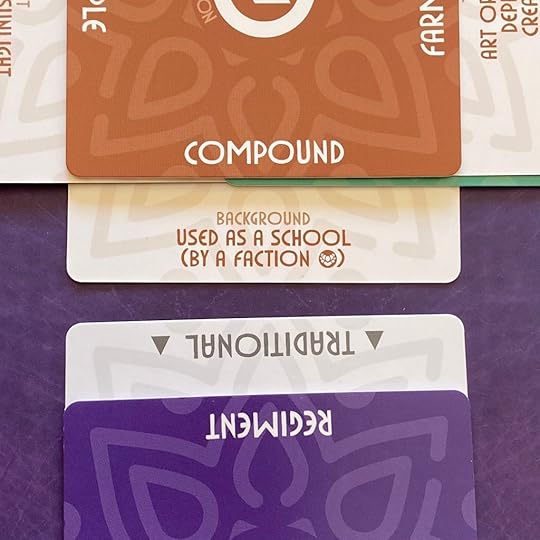Tabletop Tuesday — Lore Master’s Deck
Hey all! It’s Tuesday, so I’m back talking tabletop, and since most of what I’ve been playing lately has been Star Trek Adventures, Pathfinder (where I’m actually a player!), Star Wars (ditto!), and Mutants & Masterminds, I thought I’d bring up the third of the tools from the creators of the Story Engine Deck and the Deck of Worlds (both of which I’ve talked about before, and you can click to read those entries).
As I’ve mentioned before, those decks are a goldmine for me when I’m working on a TTRPG session, and I’m sure it won’t be long before I’m back here talking about another adventure, setting, or character spun up via the decks, but it’s only recently I really started to sit down and play with the Lore Master’s Deck—and it’s unsurprisingly awesome.
Pick a Card, Any CardLike all the deck products you can get from the Story Engine webstore, it really comes down to just drawing a card to start yourself off, but the Lore Master’s Deck is designed to—I’ll quote the instruction guide—create ideas for fictional factions, figures, events, locations, objects, materials, and creatures, and organize these ideas in a web of connections and relationships. The way it works is pretty simple, you pick one of those categories—Faction, Figure, Event, Location, Object, Material, or Creature—and you’ll be faced with four choices like many of the cards in previous decks.
 Five cards and we’re already sparking ideas.
Five cards and we’re already sparking ideas.Given I’m still in a Star Trek Adventures frame of mind from the Nyberrite Alliance groups I’ve been working on, let’s grab a location and build up somewhere for the Nyberrite Alliance. I draw a Location card, and my four options are: Temple, Channel, Farmstead, and Compound. That last one grabs my attention—maybe this’ll end up being a Balduk compound of some kind?—so I run with that.
Now, unlike the other decks, where you draw a card of each type (with perhaps one or two modifying cards) with the Lore Master’s Deck you’re striving to create a web of interlacing results, so you actually draw (up to) four more of the same type of card—in this case Location—but you flip them over. On the reverse side of the cards are potential links. These are traits or background details that you’ll tuck beneath the card you drew and use to connect new cards and… well, it basically starts sprawling from there.
Let me start with the example we already have, that Compound, and work from there. Of note, you don’t have to draw four cards—I often draw one at a time, and stop when something strikes me—but this is an example, so let’s go all in. Given I’m drawing four more cards, each with four traits or backgrounds to choose from—sixteen total—I’m not going to list all the options, but what I ended up choosing were the following four: Constant Sunlight or No Sunlight; Used as a School (by a Faction); Art or Statuary Depicting a Creature; and Mosaic(s) or Sculpture(s) (made of a Material). As you’ll see on the image there, there are symbols beside three of those cards: those represent other decks (in this case, a Faction card, a Creature card, and two Material cards). Those are meant to link in another cue via a draw from those decks (on their face-up side).
 One Lore Cluster!
One Lore Cluster!So, I grab a Faction, a Creature, and two Material cards. Each, again, have four choices, but I end up choosing “Regiment” for the Faction, “Dragonfly” for the creature, and “Polish” and “Dye” for the Materials.
This creates a “Lore Cluster.” In my case, I’ve got the image to the side there. So, we’re looking at a compound that’s used as a school for a regiment—at this point, I’ve already decided these are definitely the Balduk, the most notable warriors of the Nyberrite Alliance—and the compound itself is adorned with art and statuary denoting dragonflies (or, given this is an alien world, I decide they’re a dragonfly-analog, and are in fact closer to the ones from way back, and are quite a bit larger than the ones we have here on Earth today). Of note, these designs of dragonflies are made with polish and dye—and I’m reminded that when I came up with the Balduk, I decided they had a keratinous growth that grew up and over their skulls from their foreheads, which they called ellem, and they had a history of shaping this protective growth—and using it for tools when it broke or needed trimming. So, the decorative touches throughout this compound are made of polished and dyed ellem—and part of what this school teaches is the creation of weaponry, including using ellem to craft blades, knives, or arrowheads. As for the trait of constant sunlight or no sunlight, I’ve always been in love with the notion of tidally locked planets—so-called Eyeball Worlds—so we’ll decide this compound is located on one of those theoretical planets (after all, it’s Star Trek), and thus the sun is always up—though I’m going to say it’s also not very high in the sky, but rather it’s like it’s always just a little bit before sunset, the sun low on the horizon providing some heat, with those alien dragonflies zipping around in the wetlands around the compound hunting for smaller insect prey.
But Wait, There’s More!Now, that’s more than enough for me to have crafted a setting, and if that was all I was looking for, I could call it a day—that’s one of the great things bout all the decks from Story Engine: you use them until you’ve got an idea you want to run with, discounting any bits that don’t fit right (or, sometimes, sitting with those draws you initially frown at and asking yourself to think, ‘yeah, but could I come up with something that works for this?’)
But the Lore Master’s Deck can also keep going. Going back to my example, sure the location gave me something to work with for the Balduk regiment, but… what if I wanted more than “they learn how to make weapons at this compound”?
 You’ll soon learn to read upside-down if you can’t already.
You’ll soon learn to read upside-down if you can’t already.Well, I just tug that Regiment card out, and give it the same treatment I gave the Compound in the first place. There’s another deck full of Modifier cards, and they’ve got handy little arrows you can use to help yourself keep track of your growing lore, so after I tug the Regiment free, I draw one of those and pick a modifier. My four choices on the first side of the first card I draw are “Textured,” “Meticulous,” “Sunken,” or “Traditional,” and that last one feels like a winner because we’re talking about a school teaching people how to make knives and blades and arrows when there are phasers and space ships. This Regiment? They’re old school.
After that, you keep going as you did before, tucking (up to) three new trait or background cards on the unused sides beneath the card you just pulled out—using the reverse of the same sort of card—and see what you get. In my case, I’m drawing from the Faction deck (because I’m building on that Regiment card) and from those three cards I choose the following from the four options on each: a background, Formed out of Colonial Interests or Resistance; a trait, Masters of a Sport or Fighting Style; and an agenda, Dismantle a System or Institution—that last one has my choice of two symbols on it, either another Faction card, or a Location card. I go with another Faction, draw a Faction card and get my choice of “Office,” “Platoon,” “Group” or “Mob” and… Mob. The Orion Syndicate has come up a few times in my campaign, and they’re basically a crime syndicate mob, just Trek flavoured, so at some point this Balduk Regiment has definitely butted heads with the Orion Syndicate—they want them taken down.
As for the other two prompts: “Masters of a Sport or Fighting Style” has me definitely leaning toward the latter, deciding these Balduk are absolute masters of small blades and archery—maybe worthy of giving them a Special Rule or Talent in Star Trek Adventures to give them a game mechanic advantage when they’re using blades or bows, and I’d already decided that the Balduk were one of the few species to manage to resist the Klingon Empire when it tried to invade, so these warriors can trace their heritage back to that proud moment in their history with “Formed out of Colonial Interests or Resistance” with the latter option: they resist.
 The full spread of two lore clusters.
The full spread of two lore clusters.Now, that’s two lore clusters complete, but you can keep going as long as you’d like. Maybe next time draw the “Mob” card out to learn more about the Orion Syndicate people who specifically interacted with this Traditional Regiment of Balduk warriors, or pull out the Dragonfly card to learn about the alien creature the Regiment honours in decoration—why? What does it signify?
Given the cards can get pretty spread out, the Lore Master’s Deck also gives you these adorable little wooden arrows you can use to draw little pathways between cards, but I’ve yet to really use them (I only have so much table space). But you can see how easy it would be to keep going and going… and how much it sparks the imagination with every new draw.
As it is, I’ve got enough to work with from multiple angles here for a session. A regiment of traditionalist Balduk warriors who can trace their lineages back to the original attempted invasion of their home world, living in a compound on a tidally locked planet where giant dragonfly-like insects dart around, who have a particular dislike of the Orion Syndicate? Maybe the crew need help in finding someone who ran afoul of the Syndicate and has vanished—and the Balduk are the closest experts on the Syndicate. Or, maybe the crew are visiting the Balduk for unrelated reasons, diplomatic or trade, and the Orions use the moment to stage an act of sabotage. Maybe a Klingon Warrior with a grudge decides he wants to reclaim some family honour by taking down the regiment that successfully resisted his House’s assault on their people so many years ago. Either way, I’ve got enough to put together a session, and all via drawing some cards.
Putting Them All Together—Wait, Can I Put Them All Together?Yes. One of the great things about the Lore Master’s Deck is the back page of the instructions kit, where it points out you can mix-and-match cards from The Story Engine and Deck of Worlds—for example, instead of drawing a Location card (the Compound, in my case) I could have drawn Anchor cards from The Story Engine, or Landmarks or Regions from the Deck of Worlds—and then still used the Lore Master’s Deck to create lore clusters around what I drew. Similarly, when you’re using the Story Engine Deck, you can draw Modifier cards instead of Aspect cards, or Object, Material, or Creature cards instead of Anchor cards, or, or, or… It also helps that where possible, quite a few of the symbols are the same: Figure cards use the same icon as Agents, and Location cards use the same icon as Landmarks, for example, so you don’t often need to look at the sheet to figure out what you can draw from where.
And there are also Bridge Expansions, too, which cross the various decks over on purpose, with symbols and card types of all three core decks. I think I have every expansion they’ve done, but honestly, any one set—or even creating your own with the pdfs—are a trove of ideas.



